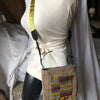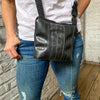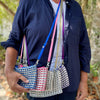The Dos and Don'ts of Luggage Tags: Getting it Right

We've all been there. You stand at the luggage carousel at the airport, anxiously waiting to spot your bag only to see several that look just like it. Worse still, there's nothing more frustrating than having your luggage - stuffed with personal belongings - mistakenly taken by another passenger, or not arriving at your destination because of a mishap.
These scenarios and their accompanying inconveniences can be largely avoided or minimized with the right approach to luggage tags, trackers, and differentiating methods. This blog post explores all the dos and don'ts for managing luggage tags effectively, ensuring you won't lose sight of your possessions again.
No Bag is Invulnerable to Loss
Let's get this straight from the off: no bag is invulnerable to loss. Whether from absentmindedness, honest mistakes, or unfortunate thefts, any bag can become separated from its owner.
Carry-on bags are no exception, due to varied reasons; from smaller overhead lockers on aircraft to gate checks, all the way to unexpected incidents like emergency landings.
The looming possibility of such scenarios underscores the importance of taking precautionary steps with your luggage. So, how do you make your bags stand out, secure them, and ensure you can track them all at the same time?
Making Your Bag Stand Out
Personalizing your bag to make it quickly distinguishable from others is the first step. This doesn't just benefit you; it makes it less likely someone else will accidentally pick up your bag. Using luggage handle wraps with built-in tags can help your bag stand out amongst the sea of similar bags.
Travel stickers, stencils, and even luggage covers add to the overall uniqueness of your luggage. However, ensure to avoid embellishments like ribbons or scarves that could catch on luggage belts and potentially cause damage.
Securing and Tracking Your Bag
A notable tool for securing and tracking your bag is technological - luggage trackers. Devices like Tile Mate or Apple AirTag are easy to slip inside your bag, and with the aid of a compatible device, you can quickly locate your bag should it go wandering.
For physical security, choose locks and luggage cables that can secure zipper points or attach your bag to a fixed object or yourself.
Some travelers might be drawn towards a low-tech luggage alarm. This can be incredibly useful in situations where your luggage could be moved without your notice.
The Importance of Luggage Tags
Luggage tags aren't there for aesthetics - they serve a significant purpose. Misplaced luggage is a common issue travelers face and having the right information on your luggage tags can mean the difference between easily reclaimed luggage or prolonged frustration.
The Dos of Luggage Tags
-
Lost-and-Found Tags: These tags help various facilitators like security staff or hotel hostesses aid the retrieval process for lost possessions. Services like ReturnMe can come in handy. Every tag you register online with them carries a unique code that allows them to return your luggage at their expense if found.
-
Details for Internal Tags: An internal luggage tag gives room for more detailed information. This tag can list addresses and telephone numbers of places you'll be staying at, providing a direct route for your luggage to follow if it gets separated from you.
-
Durable Tags: Luggage tags go through a lot, from different weather conditions to handling by different people and even machines. Durability is crucial to ensure they stay attached throughout your journey.
The Don'ts of Luggage Tags
-
Excessive Personal Information: While your tag needs enough information to help return a lost or stolen bag, care must be taken not to turn it into a beacon for potential thieves. Information like your home address can inadvertently signal your absence to burglars, so stick with minimal but effective information: name, cell phone number, and email address.
-
Non-Matching Luggage and Ticket Names: Airlines or transportation companies can contact you much faster if your luggage tag's name matches exactly the one on your ticket.
-
Reliance on One Type of Tag: Diversify the methods you use to tag your luggage. From handle wraps to external and internal tags, each has its unique advantages that can come in handy in different scenarios.
Protecting Your Checked Luggage Receipt
Yes, your checked luggage receipt plays an important role too. An attached airline luggage tag furnishes you with critical details like your flight number and destination airport. These details can be essential in tracking delayed or missing bags, so ensure you secure this receipt and make sure the tag details are accurate.
In Conclusion
It's essential to use a variety of tools to keep track of your luggage and make it easy for others to help you reunite with it, should it get lost during transit. The journey can be as beautiful as the destination, and misplacing one's luggage shouldn’t be part of the adventure. Your take on luggage tags, trackers, and aids to distinguish your luggage can mean the difference between seamless travels and unnecessary inconvenience.
So, what's your approach? Share with the community and remember, ensuring your luggage's safe return starts with getting your tags right!
-
Posted in
luggage tags





